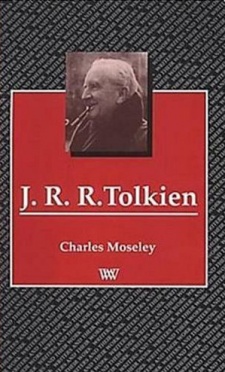J.R.R. Tolkien (Writers and Their Work): Difference between revisions
(Added disambig + displaytitle) |
m (Changed DISPLAYTITLE) |
||
| Line 15: | Line 15: | ||
Tolkien was a specialist in a recherché field. He did not, at least initially, write for a mass audience. Yet for many in the 1960s his books, particularly [[The Lord of the Rings|Lord of the Rings]], became a political badge and an interpretative text. Widely translated, his fiction won the accolade both of parody and of its own learned journal; and "Tolkien" - or how he was read - demonstrably affected modern fantasy. This book explores how his work came to be so diversely received. Charles Moseley's critical discussion examines Tolkien's view of fiction as "sub-creation", exploring his analysis of mythopoeia and of the status of art and literature in relation to his own practice. He argues that in the critical concerns of Tolkien and his circle lie the key to important issues in his fiction. His use of linguistic game and literary pastiche is explored without obscuring his emotional commitment to the making of myths that expressed some of his deepest fears about the world he experienced. | Tolkien was a specialist in a recherché field. He did not, at least initially, write for a mass audience. Yet for many in the 1960s his books, particularly [[The Lord of the Rings|Lord of the Rings]], became a political badge and an interpretative text. Widely translated, his fiction won the accolade both of parody and of its own learned journal; and "Tolkien" - or how he was read - demonstrably affected modern fantasy. This book explores how his work came to be so diversely received. Charles Moseley's critical discussion examines Tolkien's view of fiction as "sub-creation", exploring his analysis of mythopoeia and of the status of art and literature in relation to his own practice. He argues that in the critical concerns of Tolkien and his circle lie the key to important issues in his fiction. His use of linguistic game and literary pastiche is explored without obscuring his emotional commitment to the making of myths that expressed some of his deepest fears about the world he experienced. | ||
{{ | {{title|italics}} | ||
[[Category:Publications by title]] | [[Category:Publications by title]] | ||
[[Category:Scholarly books]] | [[Category:Scholarly books]] | ||
Latest revision as of 12:50, 19 October 2012
| J.R.R. Tolkien | |
|---|---|
 | |
| Author | Charles Moseley |
| Publisher | Northcote House |
| Released | December 1, 1995 |
| Format | Hardcover |
| Pages | 96 |
| ISBN | 0746307632 |
J.R.R. Tolkien is a part in Northcote House's Writers & Their Work series. This relatively short work (96 pages) was written by Charles Moseley.
From the Publisher[edit | edit source]
Tolkien was a specialist in a recherché field. He did not, at least initially, write for a mass audience. Yet for many in the 1960s his books, particularly Lord of the Rings, became a political badge and an interpretative text. Widely translated, his fiction won the accolade both of parody and of its own learned journal; and "Tolkien" - or how he was read - demonstrably affected modern fantasy. This book explores how his work came to be so diversely received. Charles Moseley's critical discussion examines Tolkien's view of fiction as "sub-creation", exploring his analysis of mythopoeia and of the status of art and literature in relation to his own practice. He argues that in the critical concerns of Tolkien and his circle lie the key to important issues in his fiction. His use of linguistic game and literary pastiche is explored without obscuring his emotional commitment to the making of myths that expressed some of his deepest fears about the world he experienced.
